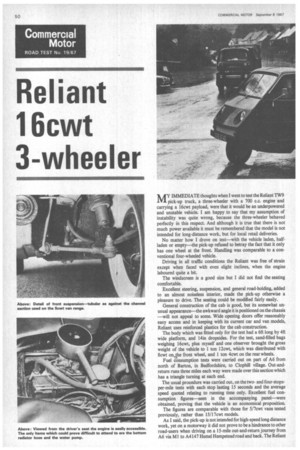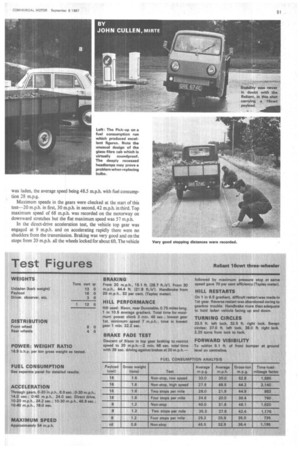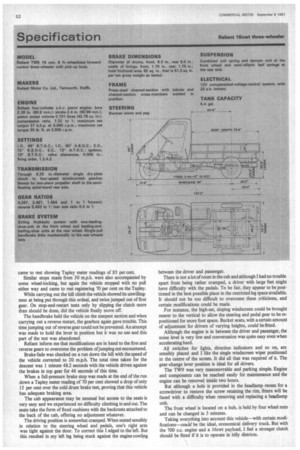• Reliant 1 6cwt 3-wheeler
Page 52

Page 53

Page 54

If you've noticed an error in this article please click here to report it so we can fix it.
MY IMMEDIATE thoughts when I went to test the Reliant TW9 pick-up truck, a three-wheeler with a 700 c.c. engine and carrying a 16cwt payload, were that it would be an underpowered and unstable vehicle. I am happy to say that my assumption of instability was quite wrong, because the three-wheeler behaved perfectly in this respect. And although it is true that there is not much power available it must be remembered that the model is not intended for long-distance work, but for local retail deliveries.
No matter how I drove on test—with the vehicle laden, halfladen or empty—the pick-up refused to betray the fact that it only has one wheel at the front. Handling was comparable to a conventional four-wheeled vehicle.
Driving in all traffic conditions the Reliant was free of strain except when faced with even slight inclines, when the engine laboured quite a bit.
The windscreen is a good size but I did not find the seating comfortable.
Excellent steering, suspension, and general road-holding, added to an almost noiseless interior, made the pick-up otherwise a pleasure to drive. The seating could be modified fairly easily.
General construction of the cab is good, but its somewhat unusual appearance—the awkward angle it is positioned on the chassis —will not appeal to some. Wide opening doors offer reasonably easy access and in keeping with its current car and van models, Reliant uses reinforced plastics for the cab construction.
The body which was fitted only for the test had a 6ft long by 4ft wide platform, and 14in dropsides. For the test, sand-filled bags weighing 16cwt, plus myself and one observer brought the gross weight of the vehicle to 1 ton 12cwt, which was distributed with 8cwt on the front wheel, and 1 ton 4cwt on the rear wheels.
Fuel consumption tests were carried out on part of A6 from north of Barton, in Bedfordshire, to Clophill village. Out-andreturn runs three miles each way were made over this section which has a triangle turning at each end.
The usual procedure was carried out, on the twoand four-stopsper-mile tests with each stop lasting 15 seconds and the average speed quoted relating to running time only. Excellent fuel consumption figures—seen in the accompanying panel—were obtained, proving that the vehicle is an economical proposition.
The figures are comparable with those for 5/7cwt vans tested previously, rather than 15/17cwt models.
As I said, the pick-up is not intended for high-speed long distance work, yet on a motorway it did not prove to be a hindrance to other road-users when driving on a 15-mile out-and-return journey from A6 via Ml to A4147 Hemel Hempstead road and back. The Reliant was laden, the average speed being 48.5 m.p.h. with fuel consumption 28 m.p.g.
Maximum speeds in the gears were checked at the start of this test 20 m.p.h. in first, 30 m.p.h. in second, 42 m.p.h. in third. Top maximum speed of 68 m.p.h. was recorded on the motors.vay on downward stretches but the flat maximum speed was 57 m.p.h.
In the direct-drive acceleration test, the vehicle top gear was engaged at 9 m.p.h. and on accelerating rapidly there were no shudders from the transmission. Braking was very good and on the stops from 20 m.p.h. all the wheels locked for about 6ft. The vehicle came to rest showing Tapley meter readings of 85 per cent.
Similar stops made from 30 m.p.h. were also accompanied by some wheel-locking, but again the vehicle stopped with no pull either way and came to rest registering 70 per cent on the Tapley.
While carrying out the hill climb the vehicle showed its unwillingness at being put through this ordeal, and twice jumped out of first gear. On stop-and-restart tests only by slipping the clutch more than should be done, did the vehicle finally move off.
The handbrake held the vehicle on the steepest section and when carrying out a reverse restart, the gearbox again gave trouble. This time jumping out of reverse gear could not be prevented. An attempt was made to hold the lever in position but it was no use and this part of the test was abandoned.
Reliant inform me that modifications are in hand to the first and reverse gears to overcome the problem ofjumping out encountered.
Brake-fade was checked on a run down the hill with the speed of the vehicle corrected to 20 m.p.h. The total time taken for the descent was 1 minute 48.2 seconds with the vehicle driven against the brakes in top gear for 46 seconds of this time.
When a full-pressure brake stop was made at the end of the run down a Tapley meter reading of 70 per cent showed a drop of only 15 per cent over the cold drum brake test, proving that this vehicle has adequate braking area.
The cab appearance may be unusual but access to the seats is very easy and we experienced no difficulty climbing in and out. The seats take the form of fixed cushions with the backrests attached to the back of the cab, offering no adjustment whatever.
The driving position is somewhat cramped. When seated sensibly in relation to the steering wheel and pedals, one's right arm was tight against the door. To correct this I edged to the left. But this resulted in my left leg being stuck against the engine cowling between the driver and passenger.
There is not a lot of room in the cab and although I had no trouble apart from being rather cramped, a driver with large feet might have difficulty with the pedals. To be fair, they appear to be positioned in the best possible place in the restricted leg space available. It should not be too difficult to overcome these criticisms, and certain modifications could be made.
For instance, the high-set, sloping windscreen could be brought nearer to the vertical to allow the steering and pedal gear to be repositioned for more foot space. Bucket seats, with a certain amount of adjustment for drivers of varying heights, could be fitted.
Although the engine is in between the driver and passenger, the noise level is very low and conversation was quite easy even when accelerating hard.
All switches for lights, direction indicators and so on, are sensibly placed and I like the single windscreen wiper positioned in the centre of the screen. It did all that was required of it. The gear-change lever position is ideal for all drivers.
The TW9 was very manoeuvrable and parking simple. Engine and components can be reached easily for maintenance and the engine can be removed inside two hours.
But although a hole is provided in the headlamp recess for a screwdriver to remove the screw retaining the rim, fitters will be faced with a difficulty when removing and replacing a headlamp unit.
The front wheel is located on a hub, is held by four wheel nuts and can be changed in 3 minutes.
Taking everything into account this vehicle—with certain modifications—could be the ideal, economical delivery truck. But with the 700 c.c. engine and a 16cwt payload, I feel a stronger clutch should be fitted if it is to operate in hilly districts.




















































































































